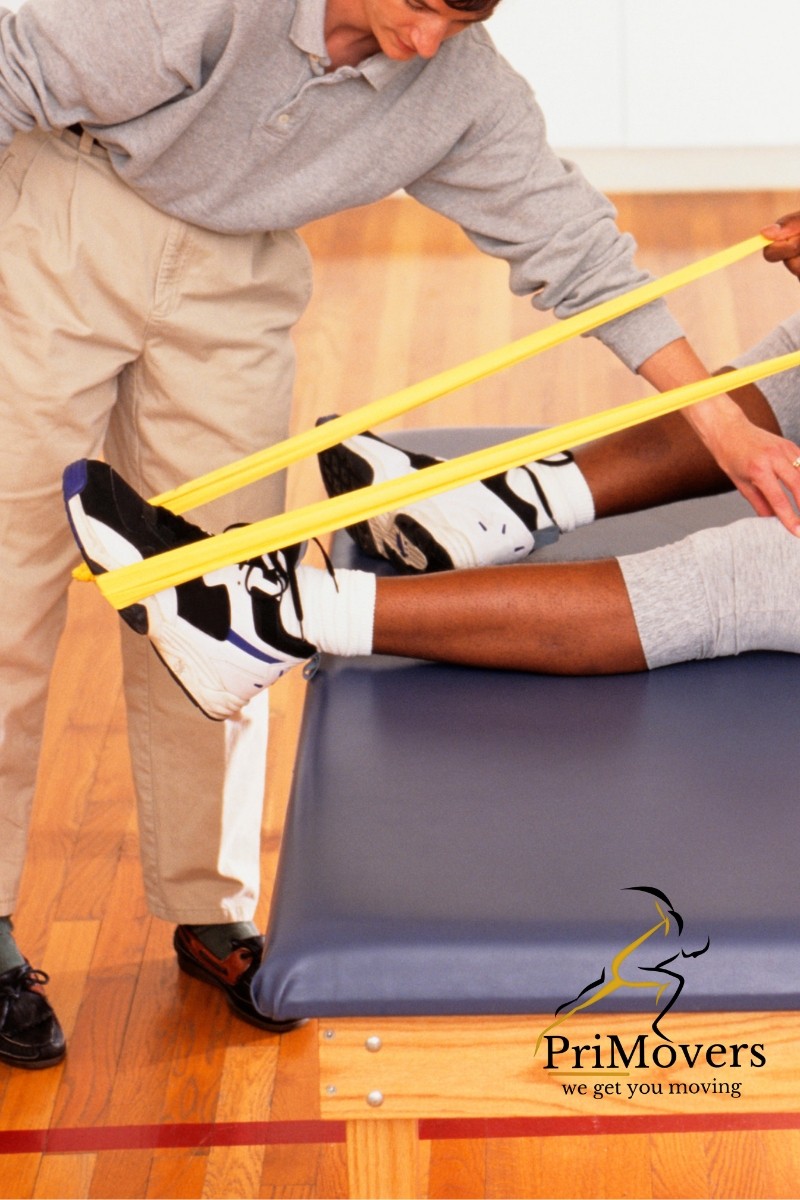Is your ankle still hurting? Learn more to get rid of ankle pain forever
Are you feeling that your ankle pain is not getting any better even after taking physician prescribed medications and rest? or
Does your ankle pain gets better for some days but comes again with more intensity after few days? orEven after following ankle treatment regime religiously every time you move a few steps at home or outside your ankle feels vulnerable to get twisted again or give you a sharp pain which is making you think how to even put a simple step in front to walk without sensing pain.
These are all are common signs of wrong ankle injury diagnosis or poor incomplete rehab and recovery methods.
But, let me assure you there is a way to get past your ankle pain struggles. Learn more about your ankle injury to alleviate your pain and improve your performance in daily activities that you enjoy doing the most.

Foot and ankle plays a crucial role in daily activities as they are first contact point of the body to the ground and designed to provide mobility and stability in the terminal structures of the lower body.
Ankle is relatively rigid to meet various functional demands of the body such as absorbing ground reaction forces and adjusting to uneven surfaces.
Any misalignment at the level of Ankle and foot results in compensatory movement patterns in the entire body which overtime results in complex musculoskeletal injuries and dysfunction at knee, hip, low back and neck.
Fortunately, most ankle injuries are not serious and get better with proper ankle stabilization and ankle rehab exercises at home.
However, if you get back to activities too soon which are very stressful to ankle before it heals completely and without doing required strength and proprioception training, it can lead to more complicated ankle/foot injury which takes very long to heal.
Below you will learn:
How Ankle Joint works?
Ankle Joint is formed by three bones of the lower body tibia, fibula and talus. Ankle is surrounded by numerous ligaments and muscles and its tendons to provide static and dynamic stability which is required to walk and run without twisting the ankle.

Failure of these ligaments and muscles to provide enough stability along with other movement faults result in various pain conditions of the ankle.
Type of Ankle Injuries?
1. Ankle Sprain (Ligament Injury): It is a very common form of ankle injury where ankle ligament is overstretched or torn due to twisting movement (as a result of poor foot/ankle stability and strength).
There are 4 important ligaments at the ankle. Some ligaments are more vulnerable to injury than other (Anterior Talofibular ligament, Posterior Talofibular ligament, Calcaneofibular ligament, Deltoid ligament).
Out of these 4 mentioned ligaments Anterior Talo-fibular ligament gets very commonly injured due to ankle inversion (internal foot rotation movement) whereas Deltoid ligament: is least susceptible to injury.
There are 3 grades of ankle injury: Grade 1, Grade 2 and Grade 3
Grade 1(mild): There is slight stretching of ligaments, symptoms are mild inflammation and swelling. It takes a week for the ligament to heal completely in this case.
Grade 2 (moderate): In this ligament undergo partial tear, you see moderate swelling around the ankle and find difficulty taking complete load at ankle while walking. Ligaments in this case heal completely in 2 weeks with physical therapy rehab.
Grade 3 (severe): In this case ligament has been completely torn. there is significant amount of tenderness (pain on touch) and instability (considerable amount of difficulty taking load while standing or walking). It takes 8 weeks to 3 months for the ligaments to heal properly with rest and physical therapy treatment.
2. Ankle Strain (Muscles Injury): In this case muscle or muscle tendon undergo damage instead of ligament.
Ankle strain injuries can also be divided into 3 categories: Grade 1 (mild muscle/tendon overstretch) , Grade 2 (partial muscle belly or tendon tear) and Grade 3 (complete muscle/muscle tendon tear)
3. Ankle Fracture: It can occur as a result of sharp impact in the ankle bones due to fall or crushing damage as in case of road traffic accidents. If one of the bones
4. Tendonitis and Tendinosis: Tendinitis is the inflammation and swelling in one of the muscle tendon (terminal part of muscle) around the ankle.
Tendinosis is the multiple microfiber tears in the muscle tendon due to repetitive load or stress on the tendon, very common in the athletic injuries due to repetitive overstretching of tight muscles/tendons without proper healing or recovery in between intense competitive training sessions.
5. Ankle Pain due to nerve entrapment: Pain in the ankle can be due to nerve getting compressed in its course from lumbosacral region(low back: origin part of the nerve) to ankle/foot (terminal part of the nerve)
Learn about common faulty systems which leads to Ankle Injuries
There are number of other reasons apart from ankle twists which result in painful ankle injuries. Learn about them here,
- Faulty movement patterns: Foot rolling inwards: Pronation, foot rolling outwards: Supination, Leg bone abnormal rotation: tibial torsion.
- Poor ankle/foot muscle strength,
- Inflexibility of the muscles around Ankle
- Wrong Forefoot to heel alignment (individual foot bones alignment)
- Improper foot landing while running and jumping.
- Lack of stability and proprioception (position sense)
- Right versus left leg difference (Leg Length Difference)
- Referred pain to ankle due to nerve compression from low back (Nerve origin area) to leg region (Nerve ending area)
Ankle Clinical Examination and Diagnosis
It's great to keep a note about how your pain started and nature of the pain. These information along with clinical assessment done by your physical therapist or doctor help in making accurate diagnosis about your Ankle problem. List of few tests done by physical therapist
- 1
Ankle passive and active Ankle movement assessment
- 2Squat test: This is an active mobility test where your physical therapist might ask you to perform few squat movement (like sit to stand from chair and back)
Purpose: To understand the movement imbalance around foot, ankle, knee and hip and low back - 3Flexibility and muscles strength tests
- 4Accessory joint mobility tests to see ankle and individual foot joints mobility/movement assessment.
- 5
Leg length difference test: Sometime one ankle can more stress than other if there is difference in length of right leg versus left. With the measuring tools like inch tape, pelvic leveler and other physical therapist test assessment is performed.
- 6Nerve compression examination test: Your physical therapist performs lower body nerve tissue tension tests to find out if the ankle pain is due to compression of any nerve down its course from low back.
Required Medical Investigations:

Medical Imaging for Ankle
Based on the impression made by your physical therapist or doctor. They might ask you to get one of the below mentioned investigation test to rule out the issue area in the Ankle. (Only in the required cases)
- X ray: Different views (AP, lateral, oblique) to see any bony changes in case of Osteoarthritis, traumatic arthritis, rheumatoid arthritis,Gout.
- MRI: To visualize soft tissue changes including muscles, ligaments, and joint capsule.
- Diagnostic Ultrasound: It helps in visualizing swelling in the muscle tendons (tendon injuries.
- Nerve Conduction Velocity Test (NCV): In this test needle and surface electrodes are used to find out the intensity of nerve signals transmission to lower body (helps in early detection of nerve compression)
Ankle Pain Prognosis
Prognosis of Ankle pain is quite good but it depends on the type and severity/grade (in case of muscle and ligament injury) of Ankle injury. Most ankle injuries take 4-6 weeks of moderate protection to heal completely.
In case of Grade 1 Ankle sprain, it usually takes 2 weeks for the pain, inflammation to subside, Grade 2 (partial ligament tear) takes 4-6 weeks. Even a grade 3 Ankle sprain with complete ligament tear doesn't require surgery but takes little longer time to heal than grade 1 and 2 of ankle (8-12 weeks)
Best Rehab and Recovery Treatment methods for Ankle Injuries
Treatment mainly depends on the diagnosis and root cause of Ankle pain.
Unless it's a fracture, ankle injuries can be treated conservatively with 100 % success in post injury performance. Best effective treatment approaches include PRICE method, Physical Therapy (involving customized flexilibility, stability/proprioception, strengthening exercises), bracing and support techniques.
PRICE: Stands for Protection, Rest, Ice, Compression and Elevation. It is considered to be the easiest, popular and most effective way in case of ankle sprain that you can use to take control on inflammation, pain and swelling associated with ankle injury.
Physical Therapy: It is an essential component towards your complete functional recovery after ankle injury and make your recovery process much easier and faster.
The goals of your physical therapy sessions include reduction of pain, inflammation, improving ankle joint range of motion, flexilibility, balance and proprioception (improving position sense of the ankle) and your return to previous level of activity and performance before ankle injury.
Unless your ankle is fractured and severely injured, you can start physical therapy immediately after injury.
Apart from rehab specific treatment techniques of mobilizing and stretching, strengthening your ankle, your physical therapist might use additional supportive techniques like bracing your ankle, splinting and kinesiology or sports tapping to provide extreme stability to ankle to enhance healing and recovery.
Physical Therapy Rehab for Ankle Injury is roughly divided into 3 phases:
Phase 1 (Maximum Protection phase): includes PRICE method of providing protection, rest, reduction of inflammation through soft tissue manipulation techniques for muscles surrounding the ankle joint, foam rolling of tight muscles around ankle, knee and hip. grade 1, 2 mobilization of ankle joint, ice pack compression and elevation of leg to reduce swelling. This phase lasts for a week.
Phase 2 (Moderate protection/Restoration phase): Emphasis on the restoration of ankle joint range, flexilibility of surrounding muscles/mobility of the hip, knee joints with functional strength training of muscles around ankle, knee and hip joint. This phase lasts for 2 weeks.
Phase 3 (Minimum protection/return to previous activity phase): Involves advanced balance and proprioceptive training to create more position sense for ankle on uneven surfaces which is gradually progressed to return to the previous functional activity level which does not involve too much twisting and turning movement of the ankle. During this phase your physical therapist determines whether you are ready to return to the sport or not. This phase lasts from 8 weeks to 3 months.

Plantar flexion with Exercise Band (for Ankle)
- Get your Ankle examined by your physical therapist or physician to avoid reoccurence of ankle injury.
- Discuss with your Physical Therapist about the reason for your ankle pain and learn various techniques that helps offloading your ankle stress.
- Learn the correct exercises by your Physical Therapist as most of the ankle pain conditions can be sorted 95% with offloading, specific stretching and strength techniques.
- Continue with your exercise program given by your physical therapist minimum 3-4 times a week even when you are pain free (as a maintenance program).




